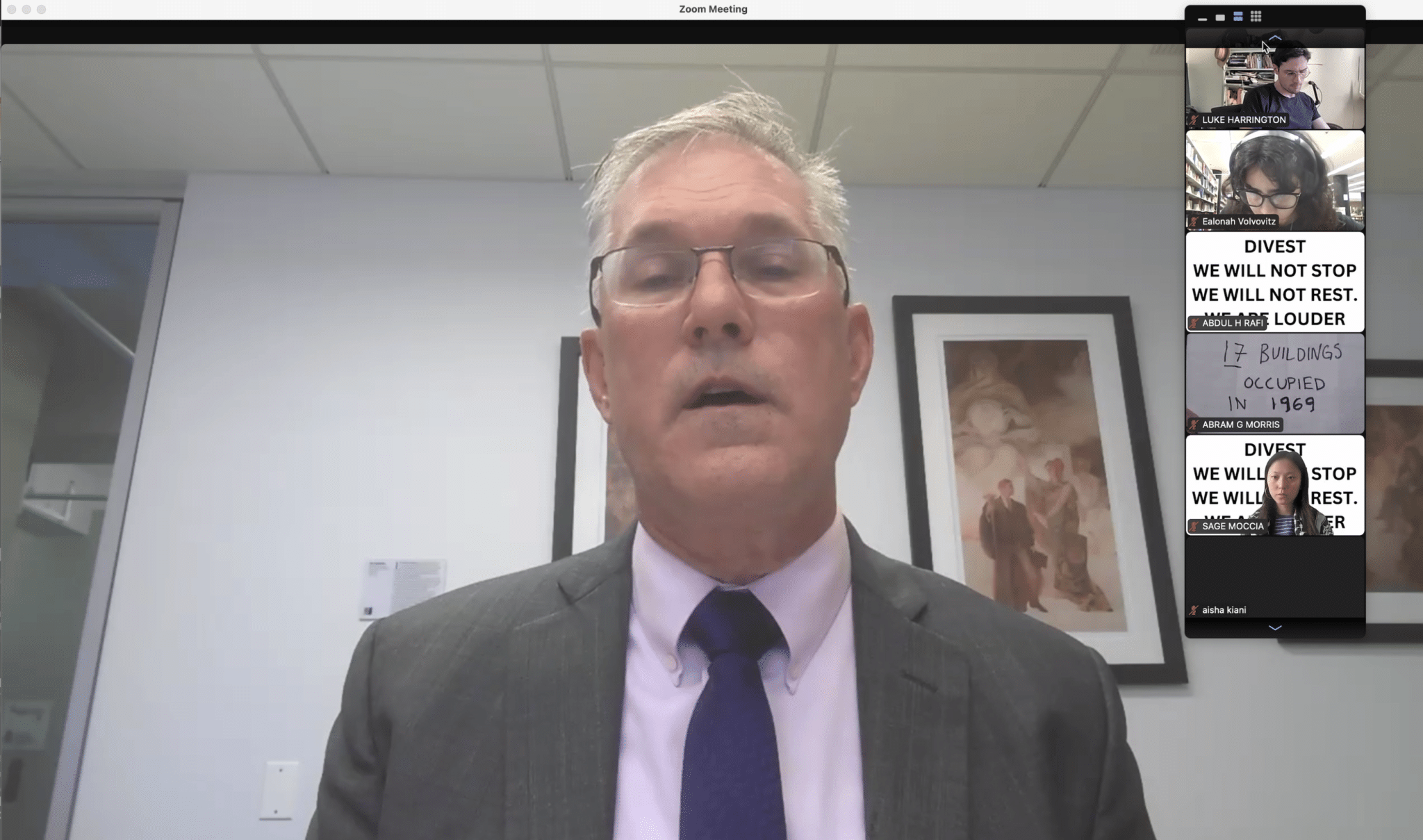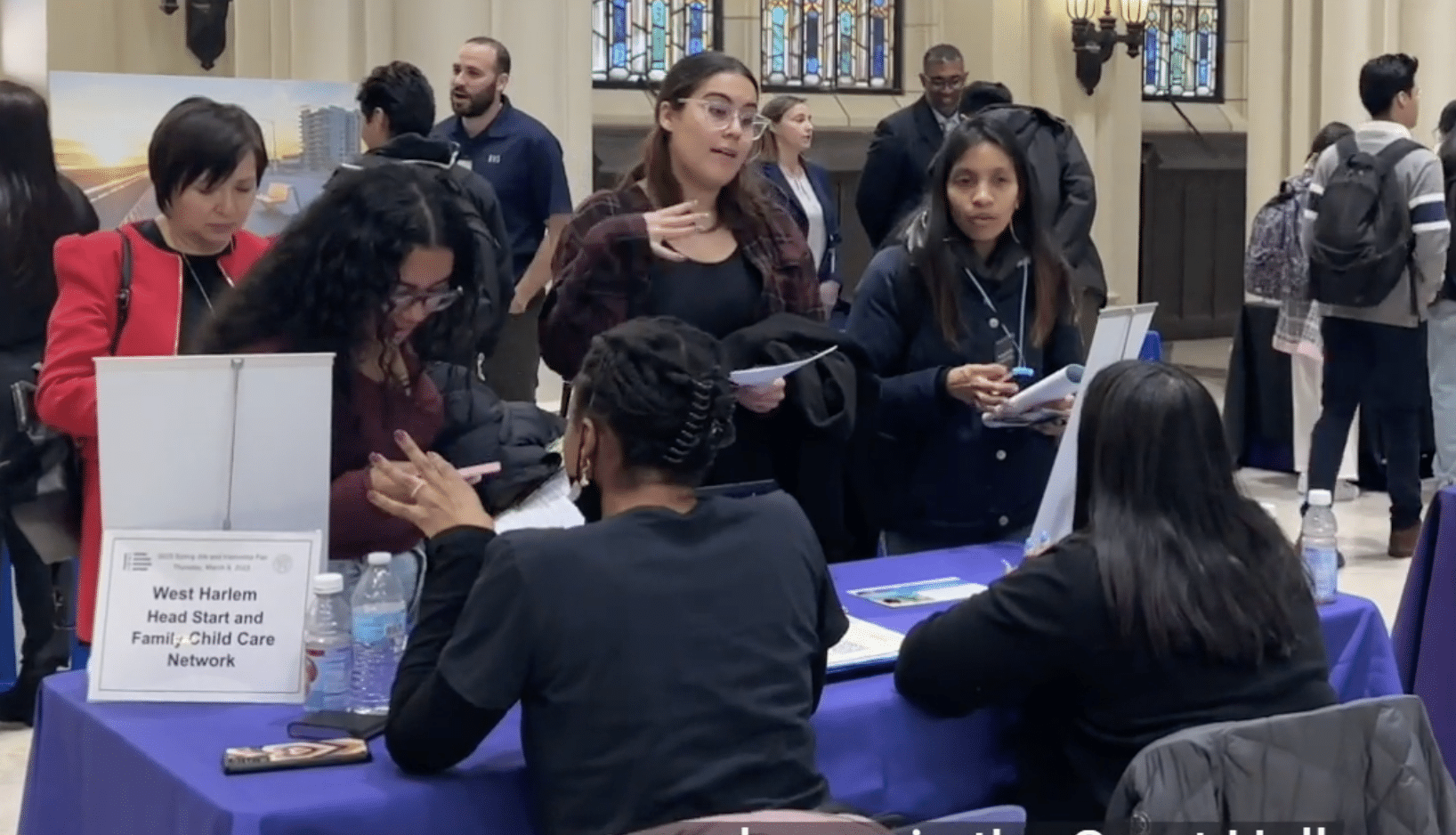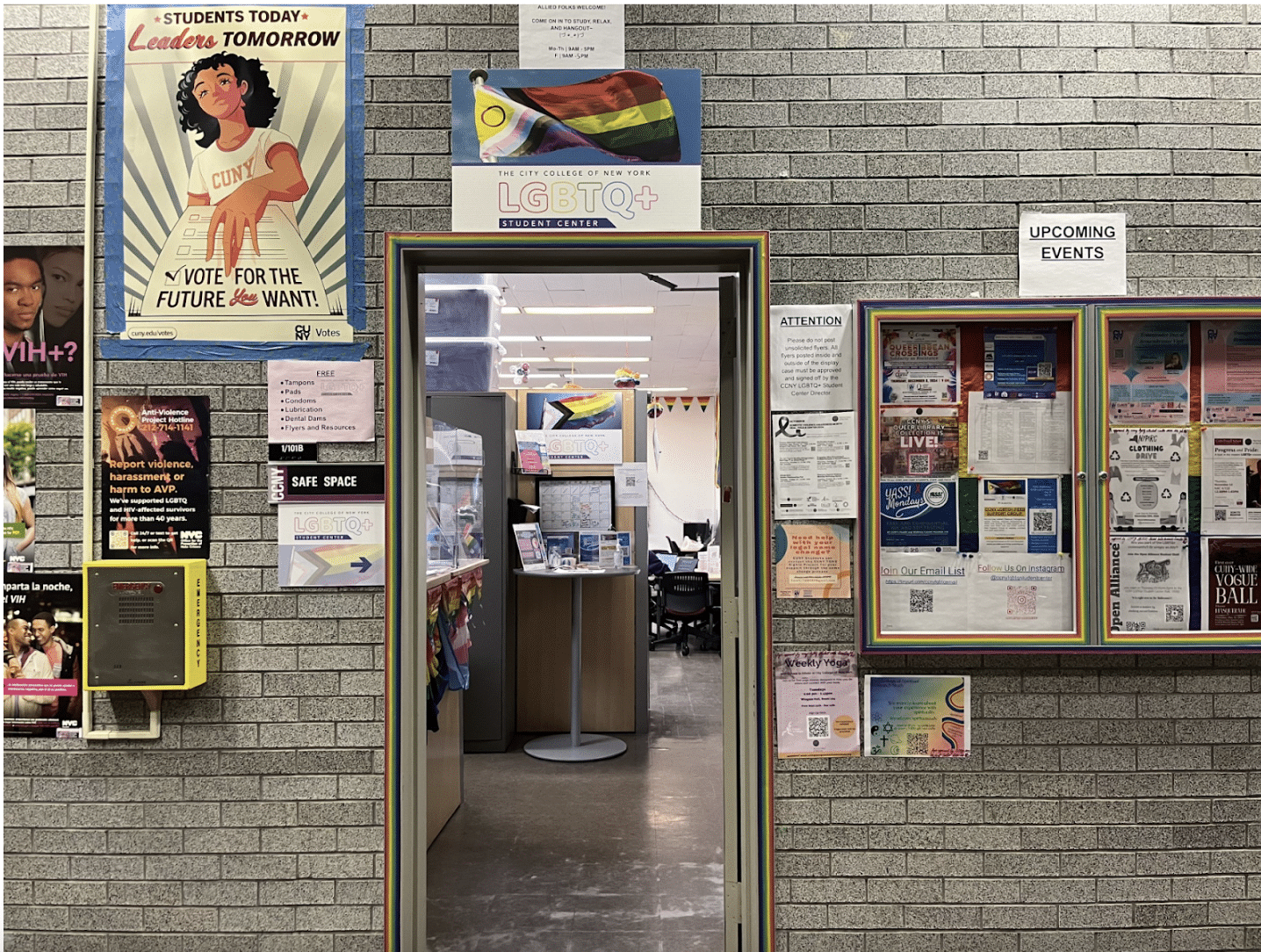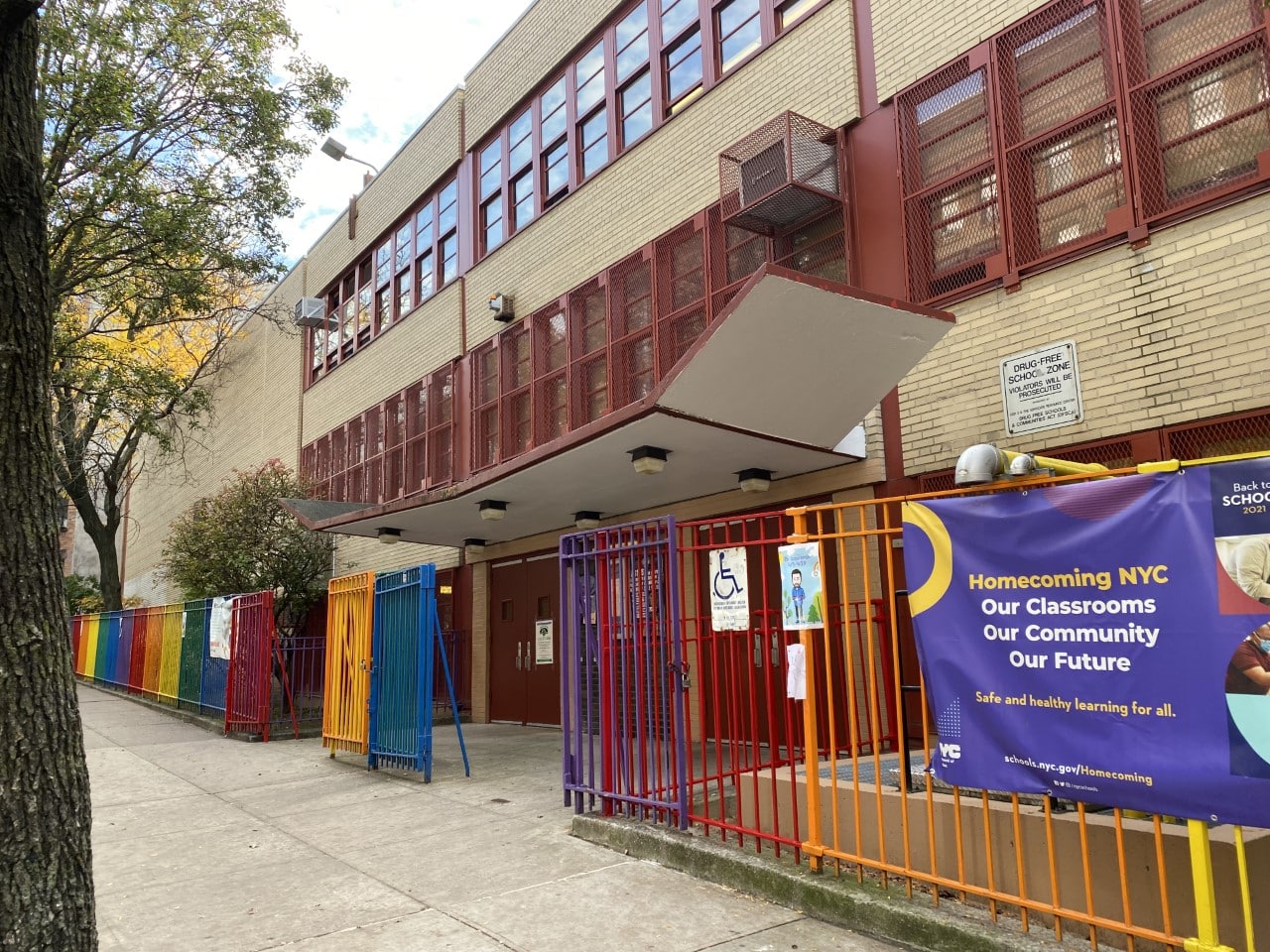CCNY President Vincent Boudreau at the student town hall meeting on May 8. Photo by Katelyn Polanco.
HARLEM, May 8, 2024
Over 500 students Zoomed into a town hall presentation by The City College of New York (CCNY) President Vincent Boudreau. He set out to explain why he called in the NYPD on April 30, after protesters took over the Wille Administration Building, and why the college dismantled the Gaza Solidarity Encampment (GSE) after six days. Some of the students had their video on with graphics behind them reading, “Divest. We will not stop. We will not rest. We are louder.”
Students, faculty, and staff have been seeking answers about why the NYPD was called and why the encampment was broken up. They also feel confused about what happens next now that most classes have been moved online. Students and faculty wonder about safety, finals, and graduation.
“I do think it was important to get an opportunity to at least begin to talk to student body about the events this past week as quickly as possible,” President Boudreau said.
For the first half an hour, he described what he saw happening in the encampment. “The protest during the day was markedly different from the protest at night,” Boudreau said. He described the protest as a “fairly peaceful encampment.” He points out that there were yoga classes, slip and slides for kids, and food stations during the day. But Boudreau said that after students, faculty, and staff left campus in the late afternoon, most people of the encampment group who stayed back were not part of the CCNY community.
“From Thursday, we had pledged not to engage the protests, not to send public safety in, not to dismantle the tents. And we held that promise even on the last day,” Boudeau said. “When the encampment was eventually dismantled, that was triggered by a decision that the protestors made unprovoked to invade Wille [Administration Building] and escalate protests across campus.”
He shared a powerpoint presentation with videos, photos, and timestamps of the moments leading up to the decision he and Chancellor Félix V. Matos Rodriguez made to bring in the police.
He explained that the first arrest was made on campus on April 25. “At 2:30 p.m. a student was arrested for spray painting graffiti on the sidewalk.” Boudreau said and acknowledged that people are upset about the arrest. But he said that he is talking to CUNY about the right way to deal with it.
The presentation showed a video posted by @Vuralelibol on Instagram of the moment public safety officers were pushed around as they tried to break up a fight. In the video, protestors chant, “We will stay!”
“This is an important moment where things change for us,” Boudreau said. He said protestors were throwing bottles and calling the officers racial slurs.
“I made a promise that our public safety officers would not enter the encampment. And that is a promise we kept throughout the next days,” Boudreau said.
The next incident that he described involved a journalist from Hunter College who wore a kippur and was pushed down the stairs and chased out of the campus. He said there was footage of this, but did not show it.
He explained that the administration began to worry when the activists in the encampment used flares at night. On April 28, he said military style flares with parachutes were fired and one hit the Marshak Science Building. It ignited a fire, which public safety officers struggled to put out with fire extinguishers left behind by construction workers. When the New York City Fire Department arrived to help, they said the college was lucky because the fire could have destroyed the entire building. President Boudreau said there was an estimated $250,000 worth of damage.
After the fire, Boudreau showed a letter that he and the chancellor sent to the encampment on April 30 asking them to voluntarily dismantle the tents by Wednesday. He also explained how the Wille Administration Building was attacked after demonstrators from the protests at New York University, Columbia University, and the Fashion Institute of Technology arrived at the CCNY campus.
“A group of activists had gotten into the back of Willie Hall and it’s about five minutes before we discover that group.” Boudreau said that the group had broken into the financial aid office where they piled furniture against the door, spray painted the CCTV, broke seven computers, and smashed two copy machines. He also said the group hit an alarm system with a fire distinguisher and threw financial aid files on the ground.
He said 33 people were arrested. One was a City College faculty member and another was a City College student and fourteen others had a CUNY connection. That night, and early morning 146 people were arrested. 45 were from CUNY schools. Over the past few days, the number of those arrested has changed and Boudreau said that is because the information the college has received is changing.
When the session opened for questions, CCNY student Samir Malik said, “I’m just wondering why we’re not talking about the violence of the NYPD against the people in the encampment.” Malik said he saw people with broken ankles and wrists and bruised faces.
In response, Boudreau said, “We have heard rumors of this. I know our student affairs team has reached out to get a kind of verified report of that. We’re actually going to try to see if we can get body cam photos from the NYPD.” He said these photos have not been confirmed and no one has come forward about any injuries. He also said that some public safety officers have been hospitalized because of the burning substance thrown on them during the Wille Administration Building break in.
Another student from the Zoom Q&A asked, “Why does CCNY public safety not use body cameras?” Boudreau said the college has already bought body cameras without approval from CUNY and officers have wanted to use them. But legal issues prevented it. “I believe that a year or so out, we’re going to have body cams but that’s a prediction,” he said.
In the chat box another student asked, “How do you plan on supporting future protests?” Boudreau said that CCNY has not required a permit from campus organizations who want to protest, even though CUNY policy protest organizers apply for a permit. “We have not enforced that on this campus. I think we probably have to enforce that. I think we have to have a really clear understanding with activists where a protest is going to take place, how long it is going to last.”
Boudreau said he believed protests have been supported by having public safety and administrators present during past protests on campus. He explained that the college has been doing test cases with a program called Sustained Dialogue, a non-profit conflict resolution group.
Boudreau emphasized the importance of building community on campus. “I think the reason why things got so out of hand is because so many people weren’t part of our community.”
Miguel J. Johnson was concerned about the college’s request for $6 million from the CUNY Board of Trustees for repairs and 100 additional public safety officers. This information was shared with faculty, but not students. “If you say the majority of the disruptors, the agitators, were non-CCNY students, then what exactly is the point of having this increased public safety presence?”
In his presentation to students, Boudreau did not explain the cost of the damage to campus buildings and other costs. He said he didn’t want students to think all the college cared about was money and the infrastructure. He explained, “We thought a really large deterrent force would be much better than trying to come afterwards and get [protestors] out of here.” But he also said that the college would not be able to afford an additional 100 officers long term.
The college put up gates on both ends of the campus on 135th and 140th street where students will be required to show ID. A student asked, “What is CCNY doing to protect students from entering the gate?” Boudreau said he believes the most effective way students are kept safe on campus is by making sure everyone on campus is part of CCNY.
“Our student activists are also students. They’ve got exams to study for and they’ve got a stake in the continuation of our academic activity. I firmly believe that. I don’t believe that any of the students that have been protesting over the course of the year would like to see the college brought to its knees,” Boudreau said.
When Alana Knights was called on, she challenged the amount of time Boudreau spent talking. “This is about us right now and what we are trying to say to you. We have barely any time to speak.”
Knights criticized the president for telling faculty in their town hall that, “My only regret is allowing the encampment to go up in the first place.”
When Knights asked how Boudreau expects students to have trust in him, Boudreau said, “My primary responsibility is for the physical safety of students on this campus, all students. My secondary responsibility close behind is to make sure the college continues to function like a college.” He explained that he understands why students are moved by the events happening in Gaza but, he said it doesn’t justify violence and vandalism on campus.
Another student in the Q&A asked, “Can you speak to the process for someone who doesn’t feel comfortable coming back to campus? And can you reference the petition that is currently online for students who don’t feel safe because of the activity of the protest?”
With over 900 signatures, a petition was made on Change.org by City College students asking to keep all classes online for the rest of the semester. “One of the things we have asked faculty to do is to be as deeply understanding to the anxieties that you feel in these last days,” Boudreau said. He encouraged students to talk to their professors with any of their concerns. “If one of [the professors] says “too bad, you have to come to campus”, I would write to the department chair. If that doesn’t work, send something to student affairs.”
Starting on May 8, the campus was reopened on a limited basis for classes that require studio and lab time. “We are going to do everything possible, not just to keep you physically safe, but to create an environment where you feel safe walking through it,” Boudreau said.
The last question came from a student who asked about the five demands presented by the protestors and any next steps to find a middle ground. “I spent most of today at a council of presidents meeting and we spent about an hour talking about how those five demands are going to be handled. They are going to be handled,” Boudreau said. He explained that all of the demands need to be decided on by CUNY, the Board of Trustees, the governor, and the state.
“There were some very serious conversation about which of those demands can be negotiated, what the process of negotiating those demands might be. I am not really in the position to tell you what the chancellor’s thinking. I don’t know that his thoughts around it are clarified, but that’s the place where that question will be answered,” Boudreau said.
The meeting ended with President Boudreau reminding students in the meeting about student life services including counseling times. He said that he understands the need for better community building. “I think the opportunity of bringing students together, listening to their fears and anxieties, getting them in conversation with one another, trying really hard to find common ground is the way forward for us.”
Tags: Alana Knights Board of Trustees CCNY President Vincent Boudreau City College Public Safety Officers CUNY Gaza Solidarity Encampment Katelyn Polanco Marshak Science Building Miguel J. Johnson New York City Fire Department NYPD Samir Malik Sustained Dialogue Wille Administration Building






